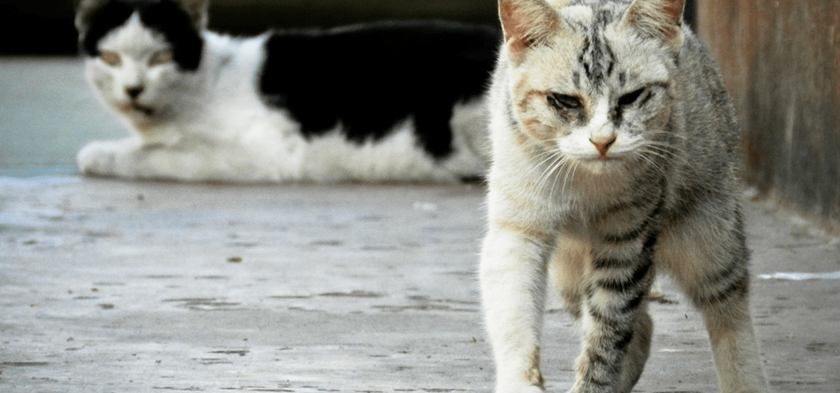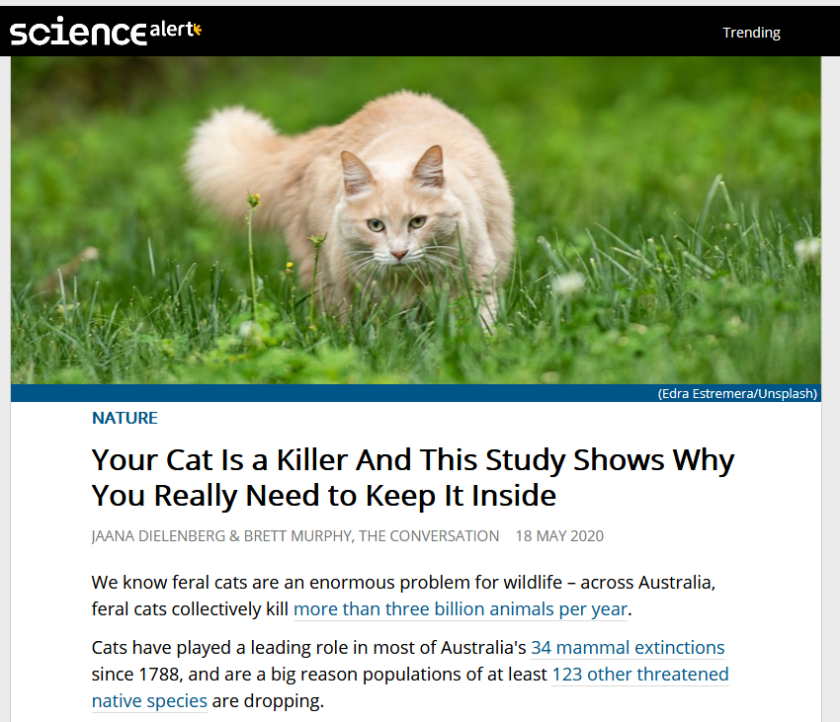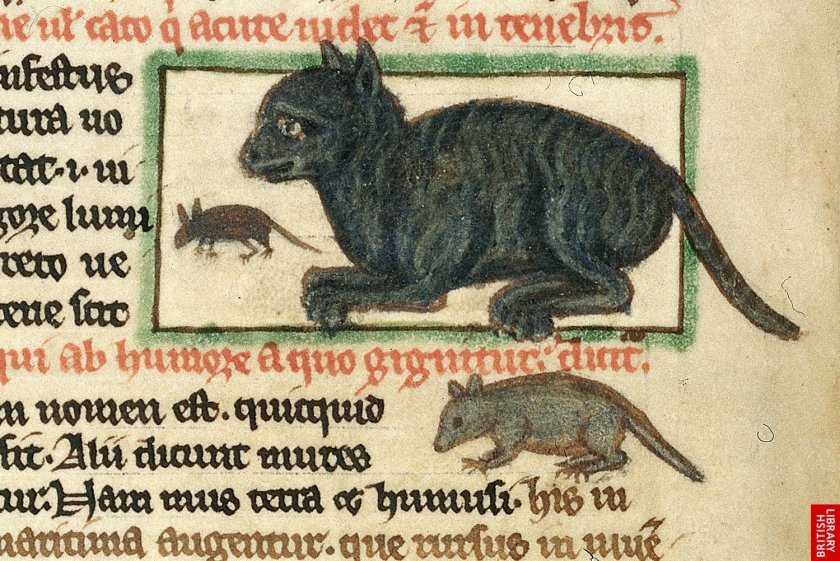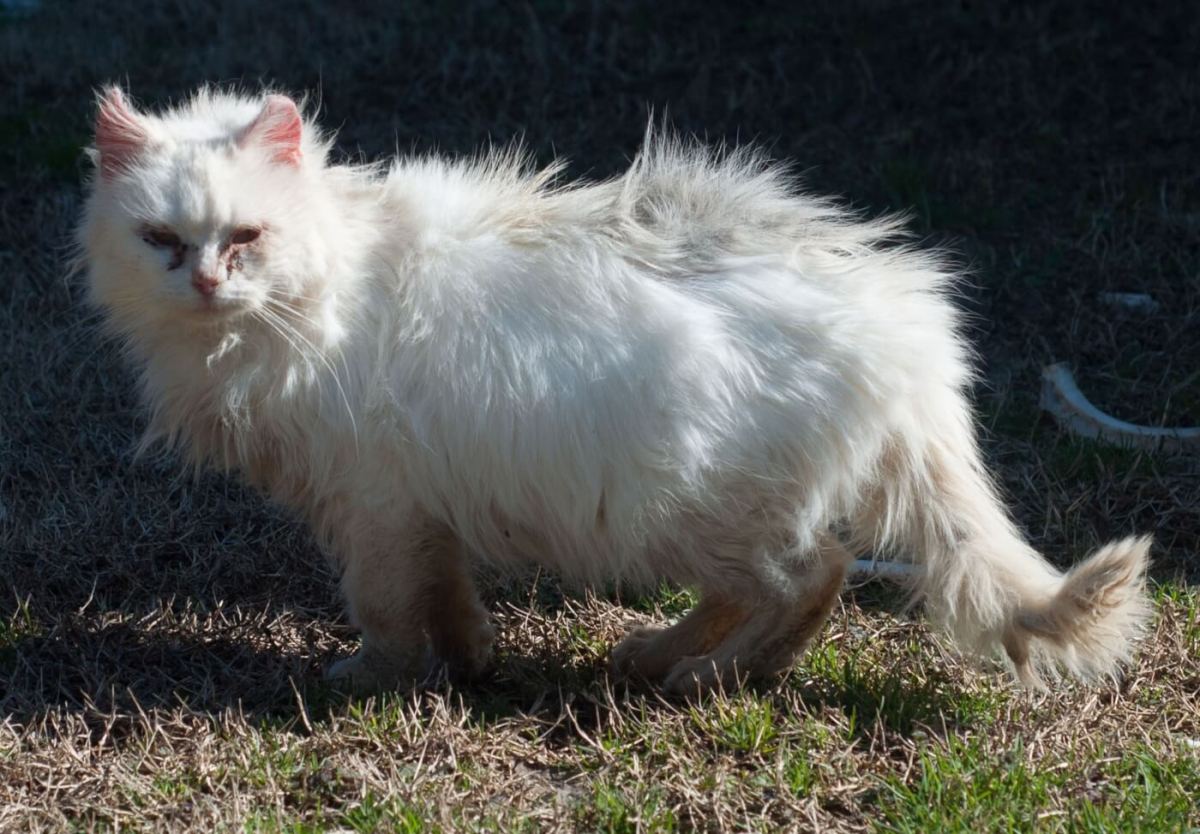What would you do if you encountered a hungry, injured feral cat hiding under a car near your home?
If your first thought is to help the poor little one, enlist the aid of a local rescue and get the cat some much-needed veterinary attention and food in its belly, congratulations: You’re a human being with a conscience.
One New York Times columnist, however, thinks the solution is to indulge in a fantasy about murdering the innocent animal, of using a weapon she doesn’t own and soundly disapproves of to wipe it from existence.
When Margaret Renkl saw the “ragged, battle-scarred tom, thin but not emaciated, with one eye that didn’t open all the way,” her first thought was to kill it, not help it.
“If I owned a gun, I swear I would have shot that cat,” Renkl wrote in her Aug. 3 column, titled “Death of a Cat. “I would have chased that hissing cat out from under the car without a thought and shot it as it fled.”
Imagine: An effete, 60-something, morally self-satisfied woman playing Charles Bronson, standing over the corpse of a cat and slipping a still-smoking pistol into its holster before heading back inside to tweet-lecture the unwashed masses on civil rights, COVID etiquette and respect for wildlife.

The staff of the New York Times really seems to be working overtime to prove it’s tone-deaf and hypocritical: It wasn’t so long ago that a Times columnist tut-tutted those who disapprove of breeding and selling $20,000 designer cats while millions of homeless animals are euthanized annually.
Times columnist Alexandra Marvar even went so far as to praise people who use their wealth and connections to flout laws against poaching illegal wildlife, reminiscing about the days when “wild cat companions were were associated glamour, class and creativity.”
“Salvador Dalí brought his ocelot to the St. Regis. Tippi Hedren lounged with her lions in her Los Angeles living room. Josephine Baker’s cheetah, collared in diamonds, strolled the Champs-Élysées. In their time, these wild creatures made chic pets,” Marvar wrote.
While Marvar romanticizes wild animal “ownership,” the reality is sadly less glamorous: Instead of Josephine Bakers leading “chic” diamond-collared cheetahs on idyllic walks through Paris, it’s Texans prodding confused and depressed tigers into tiny backyard enclosures at taser-point, insisting that “muh freedoms” guarantee them the right to treat the world’s iconic megafauna like toys.
So why does Renkl hate cats? Because she’s read bunk scientific research that claims cats kill billions of birds and small animals every year:
I was thinking of the first nest the bluebirds built this spring, the one in which not a single baby survived. I was thinking of the gravid broadhead skink who would lie on our stoop every afternoon, warming her egg-swollen body in the sun. She disappeared one day to lay her eggs and guard her nest, I assumed, but now I wasn’t sure. I was thinking of the chipmunk who lives in a tunnel under our stoop and of the little screech owl, its feet holding down some small prey, its eyes glowing in the infrared light of our trail camera.
The more I thought about those vulnerable creatures, already crowded out by construction and starved out by insecticides, the angrier I got at the feral tom. In truth, I would never kill a cat, but I can surely hate one with a murderous rage. A person who has spent a quarter-century trying to create an oasis for wildlife can go a little mad when a cat shows up in the photos on her trail camera.
Note that Renkl didn’t actually see the starving cat kill those birds or squirrels. She simply assumes that a bird who doesn’t return to her glorious backyard oasis has been gobbled up by evil felines. Her rage is prompted by emotion and assumption, not fact.
She doesn’t have a negative word to say about the construction and pesticide industries either, reserving her “murderous rage” for a raggedy cat just trying to survive because she read studies claiming cats are furry little Adolf Hitlers, exterminating birds one bloody feather at a time.
We’ve talked about those cat-blaming studies here on Pain In The Bud: They’re sloppy meta-analyses of earlier studies using plugged-in, arbitrary data and dubious numbers from questionnaires to arrive at the conclusion that cats kill as many as 20 billion small animals in the US alone.
It’s cherry-picking at its worst, beginning with a pretedermined conclusion and inventing, massaging and selecting “data” to support that conclusion rather than doing the hard work of collecting authentic data and honestly interpreting the results.
The researchers who published those studies should be mortified to have their names attached to them. They’re engaging in activism, not science.
We’re not the only ones who have a problem with the aforementioned studies. A team of scientists and ethicists examined the claims and “found them wanting,” blaming the sloppy science of those studies for the claim that “cats are a zombie apocalypse for biodiversity” and the subsequent war on cats in countries like Australia, where some states offer $10 a scalp for people who kill adult cats and $5 a scalp for kittens.
What kind of twisted logic compels people to kill kittens in the name of protecting animals?

The primary and most-cited studies claiming cats kill billions of animals “take specific, local studies and overgeneralize those findings to the world at large,” the critics wrote. The studies ignore “ecological context,” bury contrary evidence and ignore mitigating factors, like the fact that cats often prey on other animals that kill birds.
In other words, they start with a pre-determined conclusion and shape the dubious data to fit, as I wrote above.
And so the claim that cats kill billions of birds and small mammals is repeated as fact by an unskeptical press, and ostensibly serious people, like the Smithsonian Migratory Bird Center’s Pete Marra, advocate a “nationwide effort to rid the landscape of cats.” That’s a nice way of saying he wants to kill hundreds of millions of innocent domestic cats because he doesn’t want to see the glaring flaws in studies about the species’ ecological impact. (Marra also compares feral cat advocates to tobacco companies and climate-change deniers, which is an astounding claim from a man whose name is synonymous with manipulating research data to support his views.)
This is absurd stuff, akin to the extermination of cats in the Dark Ages prompted by stories alleging cats were the agents of Satan, witches and heretics, and central figures in devil-worshiping ceremonies. The only difference is the people of the Dark Ages, who didn’t know better, were driven by religious belief. Their modern day counterparts are driven by religion masquerading as science.

This is what sloppy research has wrought: An army of self-professed animal lovers stalking the dusty plains of Australia and the backyards of the United States, shooting domestic cats with pistols, bows, air rifles and pellet guns.
These people don’t seem keen on thinking about how they justify the callous culling of hundreds of millions of domestic cats — intelligent, sentient animals who have feelings — in an unproven effort to protect birds and rodents.
Renkl ends her column by telling us she got her wish, in a way. A few days later, a neighbor’s kid came to her for help after some wildlife-loving do-gooder poisoned the poor animal. As she watched the tomcat convulse and twitch in an agonizing death, Renkl stopped to take pity…on herself.
“For weeks I have been trying to understand my own tears in the presence of a dying cat I did not love,” she wrote.
To her credit, by the end of the column Renkl does acknowledge her rage is misplaced, generously allowing that a cat trying to survive isn’t evil. But that concession comes after several hundred words painting cats as the driving force behind the destruction of wildlife and presenting flawed studies as credible science.
The damage has already been done.
Featured image courtesy of PETA.


I think there is little doubt that the New York Times person is clearly an entitled psycho wishing she a weapon to kill with. She has a house, a car ( probably more than one…) she also doesn’t exactly look emaciated or starving. Bella the cat figures she owes her fellow earthlings a payback…
LikeLiked by 2 people
It’s disheartening to see activism masquerading as science given credibility in national publications like the New York Times. Unfortunately anything published in a research journal is treated as irrefutable fact, as if a deity named Science made a proclamation from atop Mount Olympos that It Is So, and we must believe because science. The problem is that these studies are belief masquerading as science, the work of zealots who never had a doubt about the conclusions they’d reach in their “studies.”
LikeLiked by 1 person
When I lived in West Virginia, I had literally a score of cats ranging the area and you already know that they bring their little trophies into the house to share with you.
The number of small animals or birds that they caught were non-existent. The birds also live outside and they are smart enough to fly away when they see a cat.
However, their slaughter of innocent butterflies was definitely a cause of the demise of several species of butterflies in that area of the country. And they have a particularly huge and hairy spider in West Virginia – I think it’s called a dock spider, but don’t quote me on that – which made me think, when I first saw one, that it was a tarantula. And I’m NOT scared of spiders. My cats caught and ate every single “dock spider” that came in the house. OMG! The savage attacks they made on that particular form of the local wildlife!
I should probably send a letter to the Times, giving them more ammo for the cat-hating that they encourage.
LikeLiked by 1 person
Insects are the one form of life that Buddy does not run screaming from. I’ve seen him kill and eat flies and small bugs…but then again I’ve also seen him fail spectacularly at catching them. Suffice to say he would not do well if he had to hunt to feed himself.
LikeLiked by 1 person
A typical drooling, half witted moron. She blames the stray cats and not the morally vacant, lazy turds who just can’t seem to get their cats fixed.
LikeLiked by 2 people
Or the turds who coat everything with insecticide and other chemicals. Or the turds who wipe away cast swaths of untouched land to make room for more strip malls. Or the turds who illegally dump chemicals that kill birds and animals.
It’s odd how some people are so quick to blame animals, but won’t acknowledge our own role as humans in wiping out entire species. Especially now, when tigers, lions, jaguars, chimpanzees, orangutans, gorillas, rhinos, elephants, pangolins and hundreds of other species are in serious danger of extinction. We did that.
LikeLiked by 1 person
Complete and utter nonsense and if the Black Death comes back we can thank the killers of the cats. Talk about backward thinking, centuries ago it was thought a good idea to kill all the cats and we lost millions of people for this huge boner, must we do this again? I don’t own a gun but I would buy a BB gun to nail her. Just kidding but the same as her nonsense.
LikeLiked by 1 person
Good point, Chloe. Some day I should do a blog post about the cat panic of the Dark Ages, because it’s both crazy and fascinating. Most of it can be traced back to one incredibly overzealous heretic-hunter who convinced the pope that cats were the central element in black masses and other heretical, demonic ceremonies. Reading the allegations now, they seem almost cartoonish in their ridiculousness, but in the 13th and 14th centuries, people took it seriously.
LikeLike
I dunno. We have some pretty crazy thinkers around now. In times to come, they will think that we are cartoonish. Although there’s nothing funny about it.
LikeLiked by 1 person
Hi Steve,
About “the cat panic of the Dark Ages” — a lot of that, including what’s in the article you linked to, is actually fake news. Pope Gregory IX’s “Vox in Rama” didn’t actually call for cats to be killed as instruments of Satan — there’s only one vague reference in it to a supposed ritual in which a cat-spirit appeared — and in fact, in medieval Europe, cats were generally well regarded because they kept down the numbers of rats and mice. There was definitely no widespread slaughter of them that supposedly exacerbated the spread of the plague. That claim has been widely repeated, even in reputable sources, but there’s no historical evidence for it — it seems to have originated as a kind of anti-Catholic myth. There’s a good article I found (via Quora) that goes into it thoroughly here: https://historyforatheists.com/2017/04/cats-the-black-death-and-a-pope/
Thanks for your excellent blog and I totally agree with another commenter that that NYT writer sounds like an entitled psycho. Very sad to read and I’m grateful to know I’m not the only one out there who is a committed environmentalist AND a committed cat lover!!
LikeLiked by 1 person
Wow. That article is such a piece of emotional manipulation.
LikeLiked by 1 person
Right? It’s weird how the columnist was primarily concerned with herself and not the suffering of the sentient animal who died horribly by poisoning. Plus I have to admit, as a longtime journalist, using the word “piece” to refer to stories or columns drives me crazy.
LikeLiked by 2 people
That’s extremely disturbing
LikeLiked by 1 person
Absolutely disgusting. Does she not realize her precious little critters often kill to eat too? This is a psychopath who clearly should not be around any animal, lest she decide it needs to be exterminated for some imagined moral failing.
LikeLiked by 2 people
That’s the scary thing, her anger (and the anger of others like her) is so arbitrary. And that’s why it’s so dangerous when media outlets report those sloppy studies blaming cats for exterminating 20+ billion birds/small mammals every year.
Don’t get me wrong, cats most definitely do hunt, but there’s no evidence to support crazy numbers like 20 billion, and there’s definitely no evidence that randomly killing them makes a dent in the problem.
LikeLiked by 1 person
As an Avid Reader of the New York Times I’m really feeling lucky I didn’t read the column because it sickens me just the thought of the column in its entirety and the fact it was even published by the New York Times upsets me. However, there is no shortage of Cruelty towards animals. Prior to the pandemic I spent a year or two before going out with my dog and feeding neighborhood feral cats at 3 in the morning otherwise I was threatened with tickets and all the types of other nonsense buy the local police department. I reached out for help and in this particular town there is literally no help and the population of the ferals was just booming. I even built them a home in a semi wooded patch in an empty lot in the dead of winter out of an old cat carrier that no longer was large enough for my cat. Some people came at clandestine times and put blankets and tarps over the small space I had build them and while people fed them in secrecy and in darkness to avoid fines and tickets I assume oh, there were others who would actually disassemble our little Tent City. I don’t even know who the other people I was dealing with were. I did on one dark night meet one feeder who did mention she knew one of the people were on the street who would disassemble and dismantle what we were trying to accomplish during a very cold winter. The strange part of the story is the family who was giving us the problem owned cats of Their Own. They had a fenced-in yard so the ferals weren’t going in or bothering them so it just hurts my heart knowing cruelty has no bounds and I will never make any sense of it as long as I live. I have a difficult time understanding how anyone can harm an animal knowingly and sleep well at night. I know many cat owners but I will speak for myself, yes I have accidentally tripped over or took a wrong step and waltzed right into my cat and my first instinct was to grab him and apologize and kiss the boo-boo even if he hated my ass at the moment I needed to do that just to let him know I didn’t mean to. Sometimes nothing makes sense and since I read the article here on the Buddy blog honestly it is haunted my dreams. Sometimes I just have to take a break from even reading about people that can even hurt an animal in their mind and justify it by some means. I know it’s not right but I have tortured this woman from this column in my mind in many ways since I’ve read the article. Until I can erase it I have no issue feeling exactly as disgusting about this author of shoot and torture the cat lady and I care nothing about her tearful aftermath. I somehow hope in my sadistic little crappy Karma way that there is a human equivalent that she can experience so that perhaps she may never experience the stupidity and error of her ways of thinking ever again.
LikeLiked by 2 people
There is a national organization that helps TNR programs. Alley Cats Allies(?) Contact them for names of other groups or help in setting up a TNR program ih your area
LikeLiked by 2 people
Good call. I know they’re active here in the New York area.
LikeLiked by 1 person
The comments here are more emotional nonsense than the article linked to and I am appalled at the manner of hatred and name-calling pointed toward this woman on behalf of a stray cat that she felt sorrow over dying despite not having owning. Yes, it states she thought about shooting that cat (namely after it had terrified her dog – which I’m certain anyone who has loved and protected something can attest to the initial instinct of protection at times being a little crazy), but she did not do this. Yet the posts here are atrocious and only further the impression that cat lovers and activists can be a malicious folk same as the type they claim others are. This does not engender a feeling of sympathy for that cat, it only furthers a dislike for the sensationalism of news (something done here too) and for the way people behave when a “cute widdle animal” is in danger or being spoken about verbally poorly online (which they can’t understand) vs. how fellow humans are treated.
Appalling. Treat others how you’d want to be treated.. Or maybe treat others as you’d want them to treat cats would get through better to the type that posted here.
LikeLike
Barbara: I understand where you’re coming from, but I think some context is in order here: There have been a handful of bunk studies claiming cats kill 20 billion birds and small mammals annually in the US, and those studies have been repeatedly cited as fact in mainstream press outlets and web publications alike, including by the NYT columnist who wrote the story discussed in this post. The problem is that not a single one of them actually has reliable data on how many animals are killed by free-roaming cats. They’re just guesses given the veneer of scientific credibility through publication in open-access, non-peer-reviewed journals.
Blind credulity is not a good thing, especially when it impacts policy-making. So readers of this blog see stories like this, which then fuel policies like one in California that allows a government agency to shoot cats that they think *might* pose a threat to endangered birds. That agency killed 10 cats in about a month in late 2020. Or polices like the bounties in certain Australian territories, which offer $10 per cat scalp and $5 per kitten scalp.
It’s 2021. We should be better than this. I’m not excusing ad hominems, but I think you have to understand the context here, which is that readers of this blog (and cat advocates in general) see story after story about cats being killed, abused and neglected, and that wears on people, so sometimes they get emotional.
LikeLike
That reporter for Times is a piece of trash. I sent people this article and they cancelled before making complaint about this vile reporter.
LikeLiked by 1 person
You probably already know this, but the biggest threat to urban birds is not cats, but loss of urban habitat. Maybe gun-slingin’ Annie could go shoot up her City Council on this topic.
I used to trap feral cats when I was in a position to do it, socialize them, and turn them over to a no-kill shelter with which I was working for them to be homed.
Finally, Caitlin Johnstone recently posted an essay on her website about the viciousness – not violence – that pervades American society today. And she’s right. This woman’s reaction to seeing an ill feral cat is vicious.
LikeLiked by 1 person
Vicious and lacking in compassion. Even if everything the author believes is true (and it’s not), a poor, suffering stray shouldn’t be punished or harmed.
LikeLike